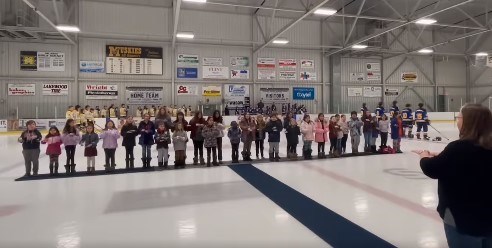FORT FRANCES — The sign language club at Robert Moore School has only been operating since January, but it’s already yielding tremendous results.
Recently, a group of students had the privilege of signing the national at a Fort Frances High School hockey game for a crowd of dedicated Muskie fans. However, their achievement does not end with a showcase of their newfound talent.
Their ability to sign has created a lifelong skill that enables them to make a connection with those people living in the community who are hearing impaired.
Open to grades 1 through 6, teacher Alyssa Armstrong and educational assistant Kathleen Matheson wanted to find a way for their students to connect with those students who are hearing impaired.
“We have a student in our class that wears two hearing aids. She has 18 per cent hearing in one of her ears. So, she has very little hearing. She signs a little bit,” said Matheson.
Matheson said her student can hear with the help of her hearing aids, but “it’s a little bit muffled” when she is instructing a room full of students.
“She doesn’t hear day-to-day conversations. She doesn’t hear what people are talking about. She needs the sign to catch her up or to explain what they just said over the loudspeaker,” said Matheson.
“She’s pretty good. She’s pretty good at speaking with other kids or speaking with an adult one on one. But to catch her up on what she’s missing out on. If you think about how many conversations, how many words people are saying or what other kids are saying, even to each other. She misses out on jokes or things like that because she really does miss a lot of everyday conversation.”
To incorporate more sign language in the classroom, Armstrong and Matheson started small.
“Within our classroom, from the time she was in grade one, we started learning "O Canada”. That was something simple I could teach to the whole group, and they pick it up really quietly,” Matheson said.
Seeing how fast and interested their student was to sign, this year, Armstrong and Matheson decided to get more students involved.
During scheduled nutrition breaks on Thursdays, students would join Armstrong and Matheson to learn some basic signs.
“For the little people, I usually try to give them something concrete like a little book that they can make and it has the signs in it and we go over them,” Matheson said.
For example, Matheson said one book would be the signs for different types of clothing. Other booklets include the alphabet, numbers, music, and emotions.
“Then they can take it home and practice or show it to mom and dad and practice at home,” Matheson said. “Because sign language is like any other language that you are learning — if you don’t use it, you will lose it.”
Armstrong and Matheson hope that the students will take what they learned outside of the school and into the community.
“A lot of the kids in the younger kids in the group live in the same neighbourhood as the little girl who is deaf. So, it’s good for them because they see her out in the neighbourhood,” Matheson said.
The benefit of having a sign language club has created a way for students to communicate with the little girl.
“I think the nice thing about the club is that, not so much that she’s learning sign language because she is already above most of the kids in our school, but that now other kids are given the tools that they the opportunity to maybe make her feel more included in her town where she’s one of the few people that doesn’t have hearing and is required to use sign language to communicate,” said Armstrong.
Armstrong admits that she has noticed the little girl’s friend group has become more inclusive now that it is easier for them to communicate.
“That’s what we are seeing. A lot of the kids that already know her are the ones that are trying to learn more because they can continue their friendship and continue to communicate with her,” Armstrong said.
Just like learning other languages, having the ability to sign can lead to many avenues in these student’s adult life.
Although some communities have small populations of hearing-impaired people, seniors care, for example, can use people with sign language skills to communicate with those that are losing their hearing.
Matheson, whose elderly family member is deaf, feels that being deaf can be lonely. Losing the ability to hear is life-altering. Communication helps human beings stay connected. Without the ability to communicate people become more disconnected.
“We want to keep everyone connected,” said Matheson.

.png;w=120;h=80;mode=crop)

